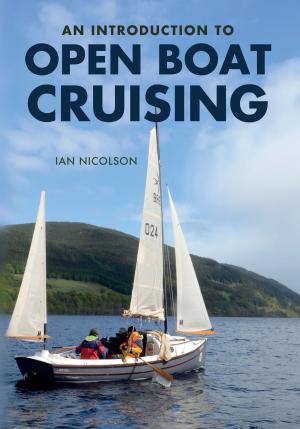| Author: | Donald Bates-Brands | ISBN: | 9781311045331 |
| Publisher: | Donald Bates-Brands | Publication: | July 31, 2015 |
| Imprint: | Smashwords Edition | Language: | English |
| Author: | Donald Bates-Brands |
| ISBN: | 9781311045331 |
| Publisher: | Donald Bates-Brands |
| Publication: | July 31, 2015 |
| Imprint: | Smashwords Edition |
| Language: | English |
February of 2015 ranked as the third coldest recorded winter in the US. We haven’t had it this cold since 1979. A disaster for some, but for the Great South Bay Scooter Club in Bellport, NY and the Sayville Yacht Club in Blue Point, New York, it meant that this last weekend of February was a rare opportunity for a small group of Scooter sailors to enjoy their craft to the fullest. Scooters are a unique form of ice boat that can sail over really bad ice relatively easily. They can even go through a hole in the ice and climb out onto the ice on the other side.
In a bygone era, it was not unusual for the Great South Bay, which lies between Fire Island and Long Island, New York, to freeze over virtually completely. But it rarely does so today. This year huge areas of the Great South Bay were frozen over.
During the 1800’s shell fishing and hunting were major activities here and there was major traffic over the ice between Fire Island and "mainland" Long Island. This ice was treacherous to get across. Men couldn’t walk on it without risk of going through. Conventional boats used during the summer couldn’t navigate the ice. Most ice boats couldn’t handle the combination of unreliable ice and open water. To this set of conditions the Great South Bay Scooter was born. The Great South Bay Scooter was designed for these conditions as a work boat.
The origin of the Great South Bay Scooter is rather hard to pinpoint. It wasn’t designed; it evolved. Life for watermen on the Great South Bay was a hard one and they didn’t stop for winter. Their equipment and their catch had to be transported across the ice and different methods evolved to do it. These boats weren’t designed by naval architects, but built by trial and error by their owners. What worked stayed and what didn’t was dropped. It amounted to Darwin’s Natural Selection.
What they all have in common is being fairly beamy (wide) for their length with four runners that run for most of bottom of the hull. The entire boat has a very shallow aspect being as deep from keel to deck as a Sunfish or Laser. The deck is curved in a manner that usually comes close to the curve of the hull. There is no rudder. The jib is the primary means of steering, followed by shifting the weight of the riders. Trim of the main sail sometimes comes into play as well.
The beauty of the design is this boat can charge across many types of ice without getting into trouble or having anything to get caught. The Scooter can sail through pressure ridges, fly over a certain amount of rotten ice, and, with some finesse, go right off the ice, cover a stretch of open water and climb up on the next sheet of ice.
The Great South Bay Scooter Club began in 1904 and is located in Bellport, NY on Bellport Bay. Historically the best ice in the area occurs here, but not this year. Hurricane Sandy breached the Fire Island Barrier Beach altering conditions on the bay. It took a few days for people to realize that the good ice was further west in Patchogue Bay, but by Saturday morning over a dozen of these ancient craft descended on the Sayville Yacht Club to try their luck.
On this Saturday, February 28, people were out in force to enjoy the ice. Altogether there were 14 Scooters on the ice that weekend. One of these was built in 1903 and was almost completely original including the canvas sails. The newest ones were made of fiberglass with high performance full batten Dacron sails. The main event was the Scooters of course, but there were also other ice craft; a converted land sailor, a conventional modern ice boat, a skate sail and even a leaf blower. Whole families came down for the event and a good time was had by all.
February of 2015 ranked as the third coldest recorded winter in the US. We haven’t had it this cold since 1979. A disaster for some, but for the Great South Bay Scooter Club in Bellport, NY and the Sayville Yacht Club in Blue Point, New York, it meant that this last weekend of February was a rare opportunity for a small group of Scooter sailors to enjoy their craft to the fullest. Scooters are a unique form of ice boat that can sail over really bad ice relatively easily. They can even go through a hole in the ice and climb out onto the ice on the other side.
In a bygone era, it was not unusual for the Great South Bay, which lies between Fire Island and Long Island, New York, to freeze over virtually completely. But it rarely does so today. This year huge areas of the Great South Bay were frozen over.
During the 1800’s shell fishing and hunting were major activities here and there was major traffic over the ice between Fire Island and "mainland" Long Island. This ice was treacherous to get across. Men couldn’t walk on it without risk of going through. Conventional boats used during the summer couldn’t navigate the ice. Most ice boats couldn’t handle the combination of unreliable ice and open water. To this set of conditions the Great South Bay Scooter was born. The Great South Bay Scooter was designed for these conditions as a work boat.
The origin of the Great South Bay Scooter is rather hard to pinpoint. It wasn’t designed; it evolved. Life for watermen on the Great South Bay was a hard one and they didn’t stop for winter. Their equipment and their catch had to be transported across the ice and different methods evolved to do it. These boats weren’t designed by naval architects, but built by trial and error by their owners. What worked stayed and what didn’t was dropped. It amounted to Darwin’s Natural Selection.
What they all have in common is being fairly beamy (wide) for their length with four runners that run for most of bottom of the hull. The entire boat has a very shallow aspect being as deep from keel to deck as a Sunfish or Laser. The deck is curved in a manner that usually comes close to the curve of the hull. There is no rudder. The jib is the primary means of steering, followed by shifting the weight of the riders. Trim of the main sail sometimes comes into play as well.
The beauty of the design is this boat can charge across many types of ice without getting into trouble or having anything to get caught. The Scooter can sail through pressure ridges, fly over a certain amount of rotten ice, and, with some finesse, go right off the ice, cover a stretch of open water and climb up on the next sheet of ice.
The Great South Bay Scooter Club began in 1904 and is located in Bellport, NY on Bellport Bay. Historically the best ice in the area occurs here, but not this year. Hurricane Sandy breached the Fire Island Barrier Beach altering conditions on the bay. It took a few days for people to realize that the good ice was further west in Patchogue Bay, but by Saturday morning over a dozen of these ancient craft descended on the Sayville Yacht Club to try their luck.
On this Saturday, February 28, people were out in force to enjoy the ice. Altogether there were 14 Scooters on the ice that weekend. One of these was built in 1903 and was almost completely original including the canvas sails. The newest ones were made of fiberglass with high performance full batten Dacron sails. The main event was the Scooters of course, but there were also other ice craft; a converted land sailor, a conventional modern ice boat, a skate sail and even a leaf blower. Whole families came down for the event and a good time was had by all.















